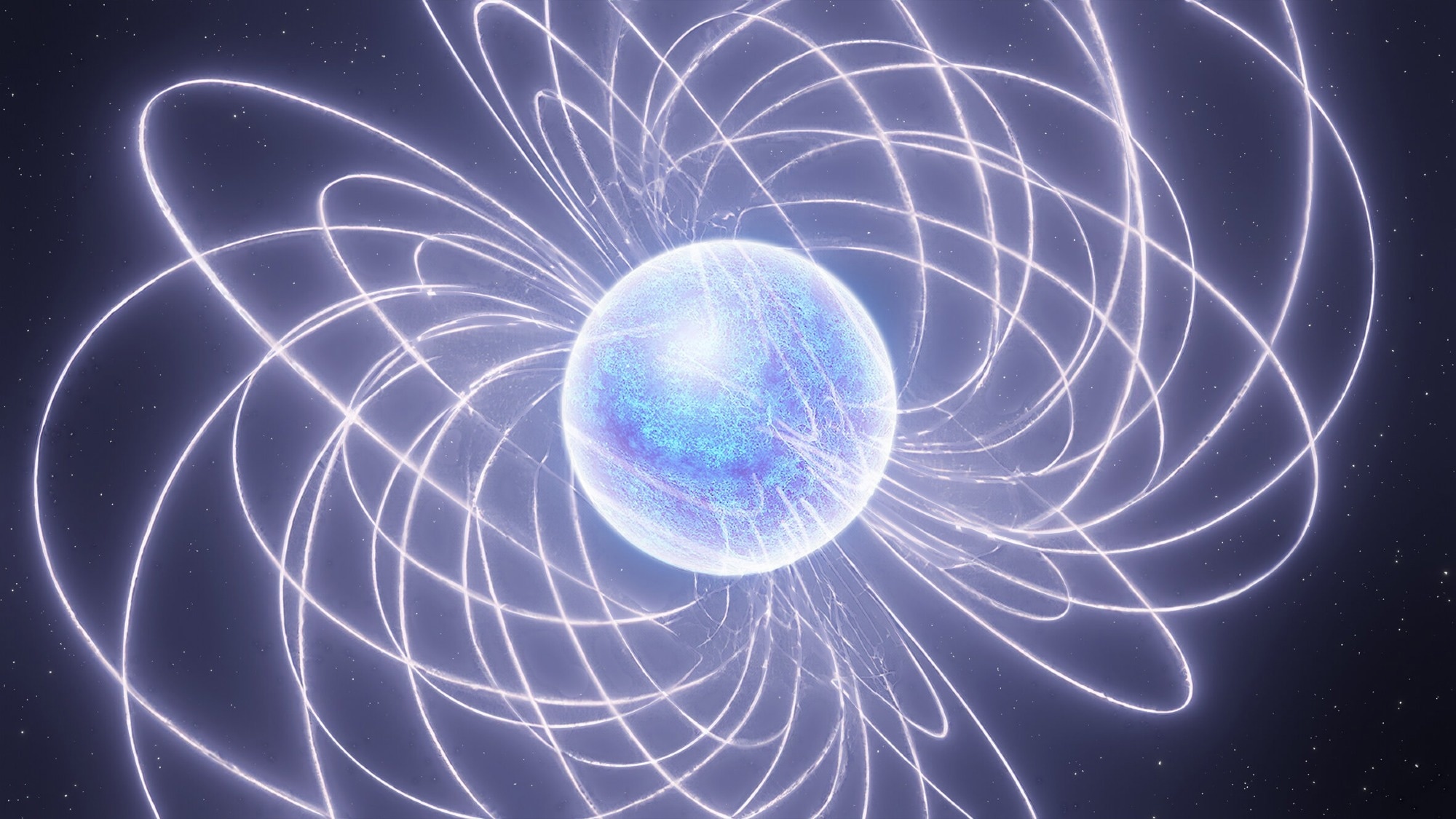An international research team studying magnetars has discovered an underlying law that seems to apply to neutron stars in general. The team is led by Michael Kramer and Kuo Liu from the Max Planck Institute for Radio Astronomy in Bonn, Germany.

Artistic impression of a magnetar, where a neutron star emits radio light powered by the energy stored in the ultra-strong magnetic field, causing outburst which are among the most powerful events observed in the universe. Image Credit: Michael Kramer / MPIfR
This law sheds information on how these sources emit radio waves and could offer a connection to the enigmatic fast radio bursts, which are radio light flashes that come from the far side of the universe. Nature Astronomy published the study.
The collapsed cores of large stars, known as neutron stars, can contain up to twice the sun's mass in a sphere with a diameter of less than 25 km. Because of this, there is densely packed matter in the cosmos that can be observed, which turns protons and electrons into neutrons—hence the name.
When a rotating neutron star directs its light toward our telescopes, it emits a radio beam that is detectable from Earth as a pulsating signal. More than 3,000 neutron stars can be seen as radio pulsars.
Although the magnetic field of Earth is just a few hundred times weaker than that of pulsars, a tiny subset of neutron stars has magnetic fields that are 1,000 times stronger. These are the objects known as magnetars. Six of the approximately thirty known magnetars occasionally release radio waves. It has been proposed that fast radio bursts (FRBs) originate from extragalactic magnetars.
With assistance from colleagues at the University of Manchester, researchers at the Max Planck Institute for Radio Astronomy (MPIfR) have examined each magnetar pulse in-depth to investigate this connection and have found sub-structures. It turns out that other neutron star sources known as Rotating Radio Transients, pulsars, and the fast-rotating millisecond pulsars all exhibit comparable pulse structures.
The researchers were taken aback when they discovered that the timescales of magnetars and the other varieties of neutron stars all adhere to the same universal law, which scales precisely with the rotation period. The inherent cause of the subpulse structure must be the same for all radio-loud neutron stars, as a neutron star with a period of nearly 100 seconds and one with less than a few milliseconds behave like magnetars.
This provides insight into the plasma process underlying the radio emission itself and allows analogous structures observed in FRBs to be understood as the outcome of a corresponding rotational period.
When we set out to compare magnetar emission with that of FRBs, we expected similarities. What we did not expect is that all radio-loud neutron stars share this universal scaling.
Michael Kramer, Study First Author and Director, Max Planck Institute for Radio Astronomy
Kuo Liu, Scientific Staff at the Max Planck Institute for Radio Astronomy, added, “We expect magnetars to be powered by magnetic field energy, while the others are powered by their rotational energy. Some are very old, some are very young, and yet all seem to follow this law.”
Dr. Gregory Desvignes, Scientific Staff at the Max Planck Institute for Radio Astronomy, further added, “We observed the magnetars with the 100-m radio telescope in Effelsberg and compared our result also to archival data, since magnetars do not emit radio emission all the time.”
Ramesh Karuppusamy, another Scientific Staff at the Max Planck Institute for Radio Astronomy, stated, “Since magnetar radio emission is not always present, one needs to be flexible and react quickly, which is possible with telescopes like the one in Effelsberg.”
Potential connection to FRBs is the most intriguing feature of the outcome for study co-author Ben Stappers.
If at least some FRBs originate from magnetars, the timescale of the substructure in the burst might then tell us the rotation period of the underlying magnetar source. If we find this periodicity in the data, this would be a milestone in explaining this type of FRB as radio sources.
Ben Stappers, Study Co-Author and Research Explorer, The University of Mancherster
“With this information, the search is on,” Kramer concluded.
Journal Reference
Kramer, M., et al. (2023) Quasi-periodic sub-pulse structure as a unifying feature for radio-emitting neutron stars. Nature Astronomy. doi:10.1038/s41550-023-02125-3